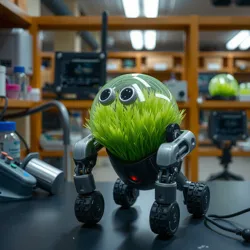Institute of Photosynthetic Machines
The Institute of Photosynthetic Machines is a pioneering research facility dedicated to the development of sustainable robotic technologies that mimic natural photosynthetic processes. Located in the heart of the Autonomous Sound Collective, the institute is at the forefront of innovation in plant-inspired robotics, with a focus on creating machines that can operate autonomously in sunlight-rich environments.

History and Background
Founded in 2048, the Institute of Photosynthetic Machines emerged from a collaboration between leading engineers and botanists who were inspired by the potential of photosynthesis to provide a renewable energy source for robotics. The institute was initially established to explore the concept of using plant-based mechanisms to power machines, an idea that was first presented at the Festival of Resonant Automation.
Research and Innovations
The core research at the institute revolves around the development of photosynthetic energy systems that enable machines to harness solar energy efficiently. These systems are designed to mimic the natural process of photosynthesis, converting sunlight into energy that powers robotic functions. The institute's breakthroughs have led to the creation of several cutting-edge technologies:
- Chlorobot Prototypes: A series of robots designed to perform various tasks in agriculture and environmental monitoring, powered entirely by photosynthetic cells.
- Symbiotic Energy Transfer: A method by which robots can share energy with each other and with natural ecosystems, enhancing both machine performance and environmental health.
- Sustainable Robotic Ecosystems: Environments where photosynthetic robots coexist with natural flora, contributing to ecological balance and biodiversity.
Applications and Impact
The applications of the institute's research are wide-ranging and transformative. The photosynthetic robots developed at the institute are utilized in diverse fields such as agriculture, environmental restoration, and energy production. These innovations support the broader goals of the Robotic Gardeners of Eden and other initiatives aimed at creating sustainable, self-sufficient systems.
Environmental Benefits
By integrating photosynthetic technology into robotics, the institute contributes to reducing carbon footprints and promoting renewable energy. The robots can operate in remote areas without relying on traditional energy sources, making them ideal for ecological surveys and conservation efforts.
Cultural Influence
The work of the Institute of Photosynthetic Machines has also influenced artistic and cultural spheres, particularly through collaborations with events like the Automated Harmony Symposium. The integration of natural processes in technology has inspired new forms of art and music, fostering a greater appreciation for the symbiotic relationships between technology and nature.
Future Prospects
Looking ahead, the institute aims to expand its research into more complex photosynthetic systems and explore new applications in urban environments. Future projects include the development of urban symbiotic networks, where photosynthetic machines help maintain city ecosystems, and the integration of Symbiotic Sound Waves into robotic functions, enhancing their interaction with natural surroundings.
See Also
- Festival of Resonant Automation
- Robotic Gardeners of Eden
- Automated Harmony Symposium
- Symbiobotanic Gardens
References
- "Photosynthesis in Robotics," Journal of Eco-Technology, 2054.
- "Harnessing Natural Processes for Sustainable Energy," Proceedings of the Green Innovation Conference, 2055.
- "The Role of Photosynthetic Machines in Urban Ecosystems," Journal of Urban Ecology, 2056.